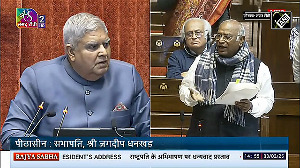As measured by the Wholesale Price Index, inflation rose to 6.7 per cent (year over year) in early 2007 from 3.7 per cent in April 2006, and has fallen to 4.3 per cent as of end June 2007. A proper assessment of whether inflation has adequately declined is crucial for conducting monetary policy now. If the economy is overheated (the view of IMF economists Kochhar and Aziz, June 5; Vivek Moorthy, May 14; and the London Economist in February and June 2007), then recent RBI attempts to tighten are warranted. But if not, then it is wrong to do so merely because of rapid GDP growth.
Surjit Bhalla is a vocal proponent of the "don't kill sustainable growth" view. Recently he forecast that WPI inflation would soon decline, and accordingly argued that the RBI policy measures of late 2006 through March 2007 were a case of belated overkill ("Inflation an ex-problem," May 17). More recently he has stressed that the GDP deflator has been close to 4 per cent for four years in a row ("When will they ever learn," June 23). This is taken as an indication, or vindication, that the RBI should not tighten. End of story? No. In our opinion, while he is correct that GDP deflator and the WPI do not indicate overheating, his conclusion that the RBI should not tighten does not follow.
In assessing India's inflation situation, the first fundamental fact to note is that intra-year swings in y-o-y inflation are huge. This is not due to seasonal fluctuations which affect the intra-year price level, but get automatically cancelled out in measuring inflation y-o-y, as done here. Instead when the price level jumps unusually in a given period (for example, week or month), the inflation rate also rises for that period, but falls back the same period the next year. This is the well-known base effect.
The base effect in India is enormous, compared to developed countries. For the last three fiscal years ending March 2007, the intra-year swings in weekly WPI inflation were 330, 260 and 440 basis points respectively. The swings in the manufacturing component of the WPI have also been enormous: 510, 365 and 350 basis points respectively. Out of its three components (primary articles, manufacturing and fuel group), the most variation in the WPI is due to manufacturing, because of its huge weight (63.75 per cent).
Viewed against this backdrop, the roughly 250 basis point inflation decline in weekly data from January to June is no big deal. In fact, it can be described as noise about noise. In general, intra-year changes in inflation in India should be ignored, due to a strong base effect. A three year moving average of y-o-y data is a good signal of underlying inflation (Vivek Moorthy, Economic & Political Weekly, Oct 6-13, 2001).
If the inflation decline is no big deal, by the same token the earlier rise between late 2006 and February 2007 is also much ado about nothing. Why then all the brouhaha early this year about rising inflation? What prompted the finance ministry to impose economically damaging export bans and price controls on wheat, sugar, milk and other commodities? And RBI actions also?
The accompanying table provides the answer. The right-most column shows that the WPI in July-Sep, 2004 soared to 8 per cent. But neither the press nor policymakers bothered too much. But when the WPI rose to only 6.7 per cent this February, there was wide discontent leading to policy reaction. Why the disparate response?
The answers is reasonably obvious. What matters for the welfare of the public is not the WPI which is two-thirds manufacturing but the Consumer Price Index (CPIs) in which primary food articles carry a much higher weight. The WPI matters for business India, while the various CPIs (industrial workers, urban non-manual, agricultural labour and rural labour) matter for the people of India.
The 8 per cent WPI rise in July-Sep, 2004 was mainly due to manufacturing which was at 7.6 per cent. Primary food inflation -- notably in pulses -- was very low. Conversely, in Jan-Feb, 2007, primary food inflation in the WPI was exorbitantly high, following similar highs, 25.1 per cent and 10.4 per cent in the previous fiscal years. The discontent due to this hardship transmitting itself through Parliament via the finance ministry seems to have led to the various price control and tightening measures.
Bhalla is correct that reports of overheating have been exaggerated. The 6.3 per cent WPI manufacturing inflation in Jan-Mar, 2007 was not a sign of overheating because it has fallen back to 5.4 per cent in Apr-Jun, 2007. Indeed, the three-year average for manufacturing WPI shows a decrease of late, despite unexpectedly robust GDP growth for four years. A productivity miracle is under way globally, leading to low inflation in items of sectors such as finished steel, despite rising iron ore costs.
However does this mean that the RBI should not tighten? No, because food inflation is unacceptably high. The pervasive focus on the WPI is obscuring information critical for the economic welfare of the people. The CPIs pertain to consumers with widely different expenditure patterns and incomes, but that does not justify ignoring them. A composite CPI weighted by population shares, or even a simple average, should be targeted.
The booming world economy, especially China and India, is pushing up demand for food and energy. This boom, coupled with George Bush-mandated and voluntary moves to corn-based ethanol is driving up wheat and corn prices, as wheat acreage gets diverted to corn in America's midwest and elsewhere. Peter Brabeck, CEO of Nestle, the world's largest food company, said in early July that "food prices are set for a period of significant and long-lasting inflation." It is misleading now to treat food inflation as due to transitory supply shocks and focus on core inflation.
The problem has been acute in Mexico, where the price of corn tortillas (their chapatis) doubled overall to about 45 cents a pound in January 2007 y-o-y, with much higher increases in some regions. This led to a 75,000 strong (repeat 75,000) protest rally in January end. China's CPI inflation for June was 4.4 per cent, the highest in three years. The bulk of the inflation was from food (running at over 7 per cent) although that has only about a one-third weight in China's CPI.
Our Prime Minister had himself stated, in his economist days, that low inflation was the best anti-poverty policy. Low primary food inflation, to be more precise, since money incomes of the poor are not automatically or fully indexed to inflation. Even if food inflation subsides, unless it turns adequately negative, the price level at which food is bought remains higher. The aam aurat faces a difficulty that the ostensibly knowledgeable economics 'commentariat' tends to be ignorant about.
The major task, in our opinion, for economic policy in emerging economies now is how best to tackle rising food prices, even when general inflation remains low. Food prices involve agriculture, trade, exchange rate, commodity futures markets and monetary policy.
Even when overall inflation is low or on target, but food inflation is too high, to avoid knee jerk price controls, banning futures and similar tinkering, should a central bank squeeze GDP growth and reduce inflation (and also allow some real currency appreciation) to lower the burden of food prices? That is a long question. It will require time for policymakers to digest that and formulate suitable responses. Hopefully, in the short run we are all fed!







 © 2025
© 2025